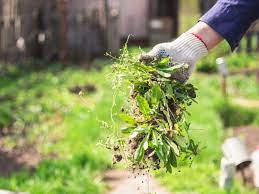You will agree with us that one of the worst things that can happen to you in a garden is that it fills up with weeds. This weed is not only ugly, it can also harm (and a lot) the species you have planted.
Eliminating them is often a high priority.
Therefore, in this new gardening article we are going to explain how to get rid of weeds. There is no 100% effective technique, but there are different methods that can be very positive.
A viable method for prevention is a good defense. However, it is almost inevitable that, in some form, they will develop. For this reason, once they have germinated, you must choose to eliminate them. There are many viable methods and all of them will be detailed in this article.
If you have a weed-infested garden or just want to know how to get rid of weeds, this post is perfect for you.
Let's get down to business!
WHAT ARE THEY AND HOW DO THEY AFFECT THE GARDEN?
Weeds, also known as weeds, are any species that grow wild (without the help of man) in a garden or green space that is cultivated or controlled by humans.
Under these conditions, almost any plant can become a weed.
As you may already know, weeds are generally considered a nuisance, an undesirable thing, and the number 1 enemy of any gardener or farmer. Removing them is not an easy task, as most grow back no matter what you do to prevent it.
The effects of gram of weed are not only related to the appearance of the lawn or the unevenness of the terrain.
When a crop or plantation is infested with these weeds, the planted plants compete with them for nutrients and water. In addition, these wild species harbor and host different types of pests.
As you can see, they are not mere spectators.
The most common species converted into weeds
As we have mentioned, a weed can be any species that develops wild and unwanted in a crop controlled by man.
Therefore, there are numerous plant varieties that come to be considered weeds. Among the most common you can find:
- Avena fatua: phanerogamous plant that inhabits cultivated land and wasteland. It has a branched root, herbaceous, erect stems and leaves up to 20 centimeters long.
- Cirsium arvense: Common thistle is a recognized herb in many gardens. It is perennial, has a deep, strong-rooted central root and has dark purple bracts. It develops in cultivated fields, pastures, in wastelands and in the clearings of the forests.
- Sorghum halepense: commonly known as cañota, it is a glabrous plant capable of developing in irrigated summer crops. Its stem is erect, reed-shaped and with a height that can reach 2 meters.
- Verbena officinalis: perennial herb native to Europe. It grows wild in meadows, spring crops, in vineyards, and in orchards. This species is erect, its leaves are opposite, lobed and divided into several segments.
How are weeds removed?
Weeds are a problem that must be rooted out, never better said.
For many gardeners and farmers, these "invasive" species come to represent a significant headache and, in many cases, significant economic losses. Therefore, its elimination becomes a priority.
However, there are no methods that can eradicate them forever.
The weed, whatever you do and whatever you put in, always ends up growing again. But, even so, it is something that should be kept trying.
Prevention
The first step to eradication is prevention.
There is no better defense against weeds than preventing them. The ideal technique to prevent the development of these species is to keep the lawn in the garden in perfect condition. With the supply of nutrients, with the irrigation and with a regular cut, you will be able to prevent (in many cases) the appearance of weeds.
A dense and healthy meadow leaves no room for its germination.
weed removal
At this point in the article, there is no room for doubt. Weeds are harmful to our crops and to our garden and eliminating them is a task that our plants will greatly appreciate.
There are different methods to eradicate weeds. All of them are highly effective and many will not even negatively affect other plants.
manual start
You will agree with us that one of the most widespread techniques to eliminate any type of grass is manual removal.
Despite being effective for certain species, it is boring, delicate, slow work and if not done well, it can even cause personal injury.
This method should be reserved for weeds that must be uprooted individually, such as those that grow attached to the stem of a tree or shrub in the garden.
If you have chosen to carry out this technique, we recommend that you wear protective gloves. Pull them up by the roots (the stem alone won't do) and if necessary, use a knife or a pointed item.
The use of herbicides
It is the most common practice and at the same time the one that can cause damage to other plants in the garden.
Herbicides must be used with caution.
These substances can save a lot of time and effort and, if used properly, may not even adversely affect your turf or cultivated plants. It all depends on how you use them.
Various types of chemical herbicides can be found on the market and it is necessary to know how each one works before applying them.
- Contact: they kill the leaf they touch. They are not residual, they do not spread to the root system and they do not persist in the soil.
- Systemic: are those that are applied to the plant. It absorbs it and distributes it to all its parts. They work very slowly, however, they are capable of killing the entire plant.
- Residuals: they are thrown directly on the ground to prevent the germination of the seeds. Unlike contact ones, they remain active for many months.


No comments yet